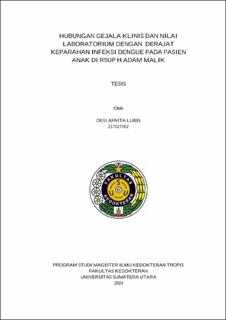Hubungan Gejala Klinis dan Nilai Laboratorium dengan Derajat Keparahan Infeksi Dengue pada Pasien Anak di RSUP H Adam Malik
Relationship between Clinical Symptoms and Laboratory Values with The Severity of Dengue Infection in Child Patients at H Adam Malik Hospital

Date
2024Author
Lubis, Desi Afnita
Advisor(s)
Pasaribu, Ayodhia Pitaloka
Daulay, Rini Savitri
Metadata
Show full item recordAbstract
Background: Dengue infection is an infectious disease caused by four dengue virus serotypes (DENV 1, 2, 3, and 4) which belong to the Flaviviridae family and are transmitted through mosquito vectors of the species Aedes aegypti or Aedes albopictus. Dengue has become a global public health problem, especially in most tropical and subtropical countries. Dengue hemorrhagic fever can attack all age groups. The majority of dengue hemorrhagic fever cases occur in children. The mortality rate in children tends to increase so it is necessary to pay more attention to clinical symptoms and laboratory values. Method: The research design used was descriptive-analytical with a cross-sectional design, with a sample size of 58 respondents. The sampling technique used was total sampling. Results: Statistical test results using the Fisher test. 37 people (63.8%) had clinical symptoms of vomiting, 20 people (34.5%) had a fever with a temperature of ≥ 400, and 15 people (25.9%) had bleeding manifestations. Laboratory results obtained hematocrit values ≥40% were 27 people (48.3%), platelet values <150,000 were 46 people (79.3%), leukocytes <5,000 were obtained by 31 people (53.4%), and abnormal lymphocytes were obtained as many as 38 people (65.5%). Conclusion: In this study, there was no relationship between fever, signs of bleeding, hematocrit, leukocytes, and lymphocytes with the severity of dengue infection.
